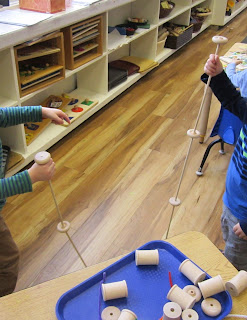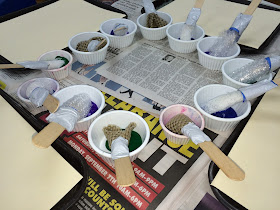Even in play based programs, sometimes it feels like
the children should be doing more than “just playing.” Recently I read an
excellent post on the Happiness Is Here blog
titled “Why I Don’t Like Play Based Learning.” The author talked about how the
term “play based” is often used to describe adult led activity, instead of genuine child-led play, which she describes play as: “self chosen, enjoyable, inherently valuable, and
unstructured.” In a child focused view of "play based" the emphasis should be on the process of play, not the product.
One of the key aspects of true play based learning is
the opportunity for children to engage in social interaction and negotiation,
and to have opportunities to develop self-regulation, planning and other skills
that we often refer to as “executive functioning”. Teachers sometimes have a
hard time noticing that these skills are being used and practiced, because
their development isn’t as obvious as a discrete academic skill. It’s easy to
see a child sorting blocks by size, it’s a lot harder to see a child using
non-verbal cues to negotiate a place to sit on a block structure. And much of
what is learned through “just playing” can’t be quantified or classified. It’s
the experience and the process itself through which the learning happens.
I see this happen every day in my classroom, most
often in the “block area”, which isn’t a block area so much as an area that,
among many other things, happens to have blocks in it. The main attraction of
this space is its space – a large rug where there’s room to build with
large blocks, spread out rows or piles of loose parts, or to just move around.
The other day, one of the children carried a basket full of small plastic animals over to a large hollow block that was balanced on its side, and slowly poured the animals into it. This soon attracted a larger crowd, as children huddled around to peer into the colorful pool of animals.
“I think I can reach it”, someone said, and put their hand in to pull out just one piece. Then the next person had to try it, as they each took a turn reaching into the block and excitedly examining the animal in their grasp.
I think it needs to be higher,” one of the children
said, and another came quickly to join him in lifting a block onto the first
block. Looking at the two-story block, the builders attempted to reach in and
discovered that it was too high, so they took down the block.
Their audience remained huddled around the animal
filled block, gazing inside. Suddenly one child sat down and swung her foot
into the hollow space. “I think I fit in here,” she said. The conversation
turned to who wanted to try putting their foot into the space to see if it
would fit.
Meanwhile, around them, construction had begun.
Turning their attention away from the block that a foot could fit into, the
children who had started the structure joined in with the construction crew who
had just joined them.
Eventually, they all left their building and pushed some blocks back against
the wall. They sat on them, and stood on them, and smiled and laughed at each
other as they lay down and slid down slanted blocks to the bottom.
I wouldn’t have been able to observe their play and document skills by marking them off on a checklist. Maybe if I was pushed to describe what they
were learning I’d say something about spatial skills and cognitive reasoning.
But the real learning was in their ongoing interactions as they were “just
playing” – from reaching into the blocks and sticking their feet inside, to
sitting and relaxing while smiling and giggling. There’s no way we as teachers
can force that learning to occur. We just need to create spaces where it can
just happen.



































